Did you know that the Philippines’ artistic landscape underwent a dramatic transformation during the 333 years of Spanish colonization? This period marked the fusion of indigenous creativity with European techniques, creating a unique cultural identity.
Before the Spanish arrived, local traditions thrived. However, the introduction of Western practices, such as painting and sculpture, reshaped the country’s creative expression. Spanish patronage played a key role, establishing institutions like the Academia de Dibujo in 1821.
This blend of styles not only enriched the Philippines’ cultural heritage but also reflected its history and traditions. From religious themes to secular subjects, the evolution of art during this era tells a story of resilience and adaptation.
As we delve deeper, we’ll explore how these changes laid the foundation for the Philippines’ vibrant artistic legacy.
Key Takeaways
- Spanish colonization introduced European techniques to the Philippines.
- Indigenous creativity blended with Western practices to create unique art.
- Spanish patronage led to the establishment of formal art institutions.
- Art during this period reflected the country’s history and traditions.
- The fusion of styles shaped the Philippines’ cultural identity.
Historical Foundations of Filipino Art in the Pre-Spanish Era
The roots of the country’s artistic heritage trace back to its pre-colonial era. Indigenous communities expressed their culture through a blend of visual and oral traditions. These practices laid the groundwork for the nation’s rich artistic legacy.
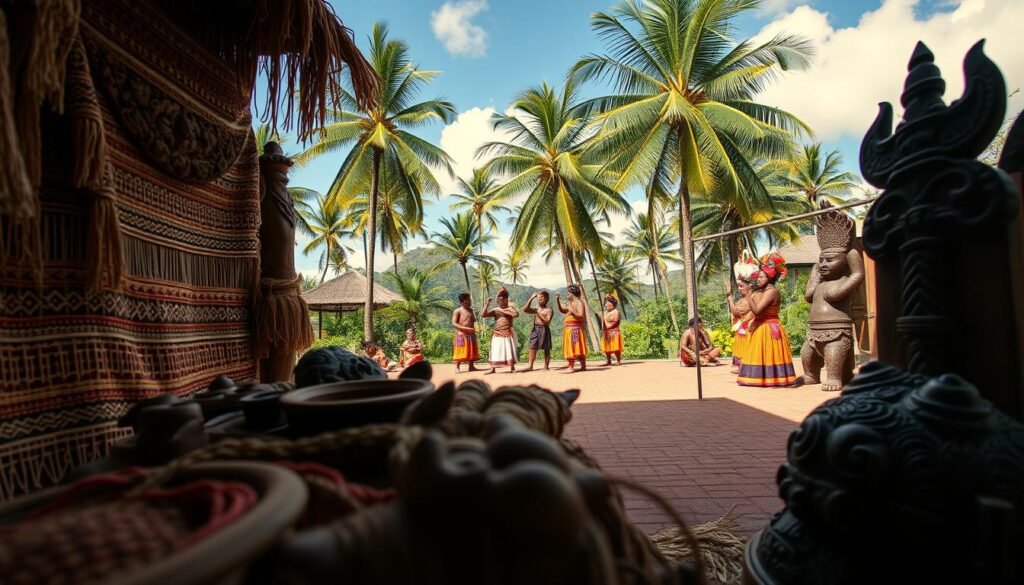
Indigenous Practices and Oral Traditions
Early artisans used storytelling to preserve ancestral narratives. These tales were often depicted in visual and performance arts. Paintings and carvings served as mediums to capture everyday life and mythic stories.
Communities played a vital role in maintaining these traditions. Through collective effort, they ensured the continuity of their cultural heritage. This communal approach highlights the importance of art in pre-Spanish society.
Ancient Visual Symbols and Ritual Art
Ancient carvings held deep symbolic meaning. They represented ritual practices and indigenous beliefs. These works were not just decorative but also served spiritual and cultural purposes.
Artists used natural materials to create intricate designs. Their work reflected the connection between the community and its environment. This blend of creativity and tradition shaped the artistic identity of the region.
The significance of these early practices cannot be overstated. They provided a foundation for later artistic developments. Even today, these traditions influence the country’s vibrant cultural landscape.
The Spanish Encounter: Transformation of Art and Culture
The arrival of Spanish colonizers in the 16th century marked a turning point in the region’s creative traditions. This period introduced European techniques and religious themes that reshaped local practices. The fusion of indigenous and Spanish styles created a unique cultural identity that still resonates today.
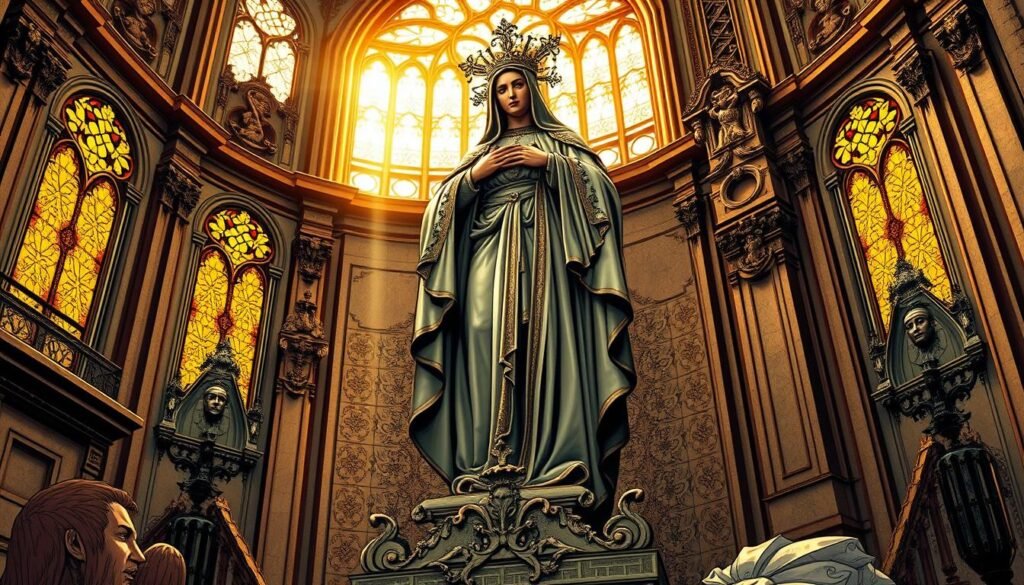
Introduction of Religious Iconography and Techniques
Spanish friars played a pivotal role in bringing religious iconography to the region. They introduced themes like the Virgin Mary and Christ, which became central to local sculpture and painting. These works were often displayed in churches, serving both spiritual and educational purposes.
Local artisans were trained by Spanish masters in new techniques. This collaboration led to the creation of intricate carvings and detailed murals. Figures like Juan emerged as key figures, inspiring local adaptations of European styles.
One notable example is the carved santos, which blend indigenous craftsmanship with Spanish religious themes. These works reflect the deep spiritual connection of the time and the skill of local creators.
“The blending of styles during this period was not just an artistic shift but a cultural revolution.”
Church murals also became a significant medium for storytelling. They depicted biblical narratives while incorporating local elements. This approach made the stories more relatable to the community.
The 16th to 19th century was a transformative era for creative expression. The introduction of European methods and the collaboration between Spanish and local artists laid the foundation for a vibrant cultural legacy.
Filipino Art Forms Transformed by Spanish Influence
The Spanish era brought a wave of change to the region’s creative practices. European methods and materials were introduced, reshaping local craftsmanship. This fusion of styles created a unique cultural identity that continues to inspire today.
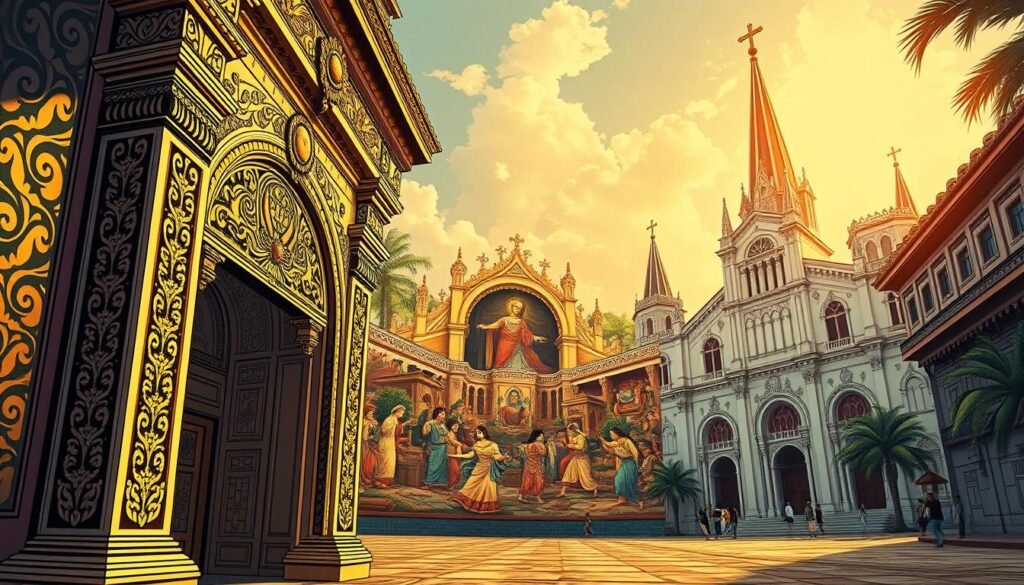
Adoption of European Methods and Materials
During Spanish rule, local artisans began using European techniques. Traditional organic materials were replaced with structured, durable options. This shift improved the visual quality and longevity of their work.
For example, painting on canvas became popular, replacing earlier methods. Religious artifacts for church interiors were crafted with precision. These changes reflected the blending of indigenous and European styles.
Museums play a crucial role in preserving these transformed works. Family collections also help keep this heritage alive. Together, they ensure that the story of this artistic evolution is not forgotten.
| Traditional Materials | European-Influenced Materials | Impact |
|---|---|---|
| Wood, bamboo, and natural dyes | Canvas, oil paints, and metal | Enhanced durability and detail |
| Handwoven textiles | Imported fabrics and patterns | New styles and techniques |
| Local clay and stone | Marble and fine ceramics | Elevated craftsmanship |
The adoption of these new methods was not just about materials. It also involved learning advanced techniques from Spanish masters. This collaboration enriched the region’s creative landscape.
Today, these transformed works are celebrated in museums and private collections. They remind us of a time when cultures merged to create something extraordinary. This period remains a cornerstone of the nation’s artistic history.
The Role of Religious Art in Shaping Visual Identity
Religious imagery became a cornerstone of cultural expression during the Spanish colonial period. The church played a pivotal role in commissioning works that conveyed Catholic narratives, blending European styles with local traditions. This fusion created a unique visual language that educated and inspired the community.
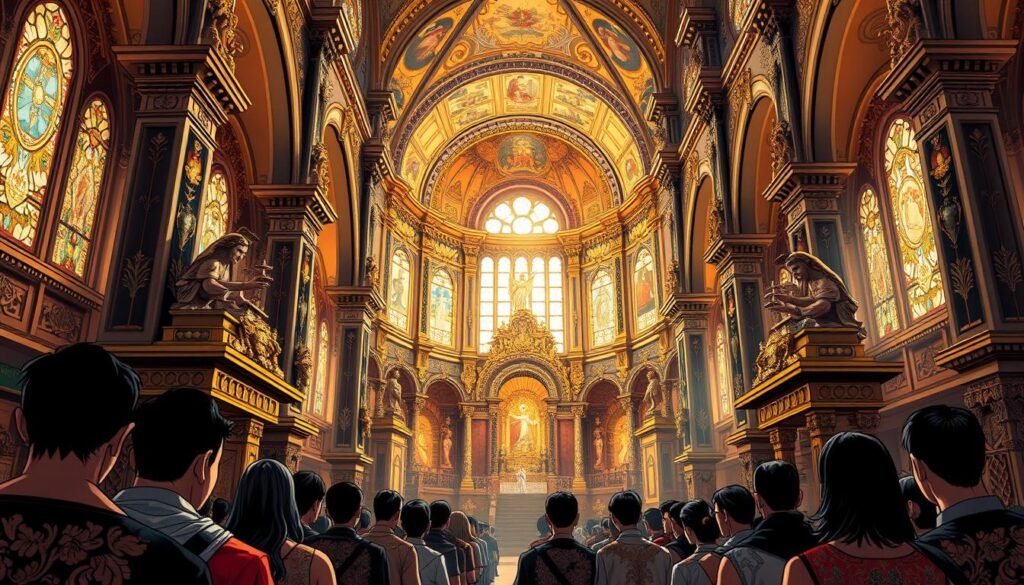
Creation of Carved Santos and Church Murals
Carved santos and church murals were central to this transformation. Local artisans, trained by Spanish masters, crafted intricate religious figures and detailed murals. These works often depicted biblical stories, making them accessible to the local populace.
The production process involved meticulous techniques. Wood was carefully selected and carved, while murals were painted with vibrant colors. These pieces not only served as devotional tools but also as educational resources for the community.
Integration of Catholic Narratives in Local Art
The integration of Catholic themes with indigenous tradition resulted in a distinctive art form. For example, the Santo Niño image became a powerful symbol, blending local customs with religious significance. This fusion reflected the deep spiritual connection of the time.
“The blending of styles was not just an artistic shift but a cultural revolution.”
Today, these works continue to be revered, preserving a rich tradition that bridges the past and present. They remind us of a time when cultures merged to create something extraordinary.
Secular Movements and Emerging Art Techniques
The 19th century marked a pivotal shift in the Philippines’ creative landscape, as secular themes began to dominate. This era saw the rise of portraiture and genre paintings, reflecting the growing influence of the ilustrado class. These works captured the essence of everyday life, moving away from the religious focus of earlier periods.
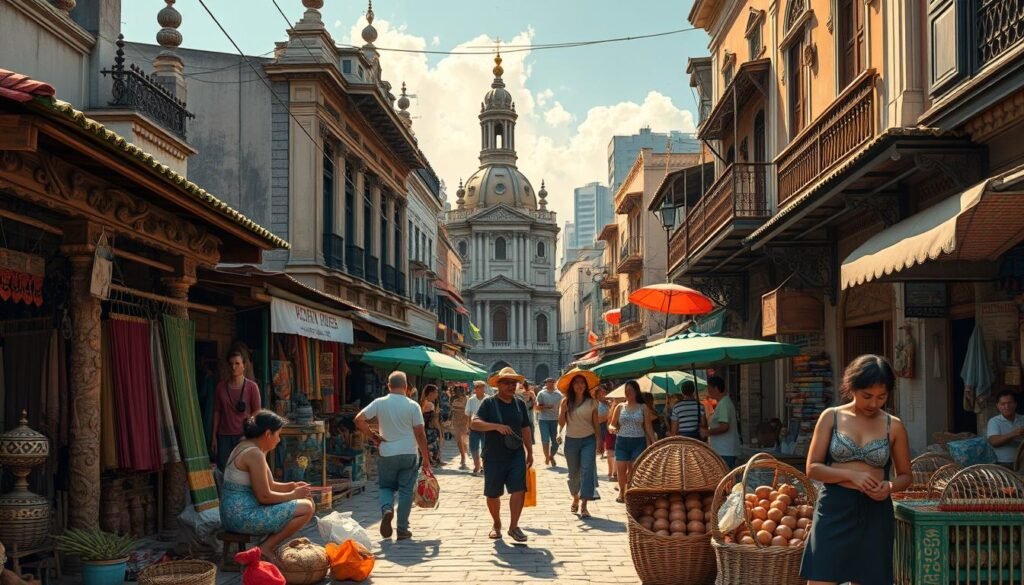
Rise of Portraiture and Genre Paintings
Portraiture became a powerful medium for expressing individual identity. Artists began to focus on the person, showcasing their unique characteristics and societal roles. This shift was a departure from the communal themes of pre-colonial and Spanish-era art.
Genre paintings also gained prominence, depicting everyday scenes and cultural moments. These works offered a glimpse into the lives of ordinary people, from bustling marketplaces to serene rural landscapes. They became a way to document and celebrate the nation’s evolving culture.
Adaptation of Traditional Wood Carving
Traditional wood carving continued to play a significant role, even as new techniques emerged. Artisans adapted their skills to create modern interpretations of classic forms. This blend of old and new highlighted the resilience of traditional practices.
For example, carvings of religious figures evolved to include secular subjects. The use of wood remained central, but the themes became more diverse. This adaptability ensured that wood carving remained relevant in a changing artistic landscape.
“The blending of traditional and modern techniques created a unique artistic identity that continues to inspire today.”
Interplay Between Tradition and Modernity
The interplay between tradition and emerging techniques defined this period. Artists drew on their cultural heritage while embracing new methods. This fusion resulted in works that were both innovative and deeply rooted in history.
For instance, genre paintings often incorporated traditional motifs, creating a bridge between past and present. This approach not only preserved cultural traditions but also allowed them to evolve in meaningful ways.
| Traditional Techniques | Modern Adaptations | Impact |
|---|---|---|
| Wood carving | Secular subjects | Preserved tradition while embracing change |
| Religious themes | Genre paintings | Documented everyday life |
| Communal focus | Individual identity | Highlighted personal stories |
This period of transformation laid the foundation for the Philippines’ vibrant artistic legacy. The rise of secular movements and the adaptation of traditional techniques continue to influence contemporary creators. For more insights into this evolution, explore the development of Filipino art forms under Spanish.
Expansion of Artistic Expression: Sculpture, Engraving, and Beyond
The evolution of artistic techniques in the Philippines expanded significantly during the 19th and 20th centuries, embracing new forms like engraving and graphic arts. This period marked a shift from traditional methods to more diverse and innovative practices, enriching the country’s creative landscape.
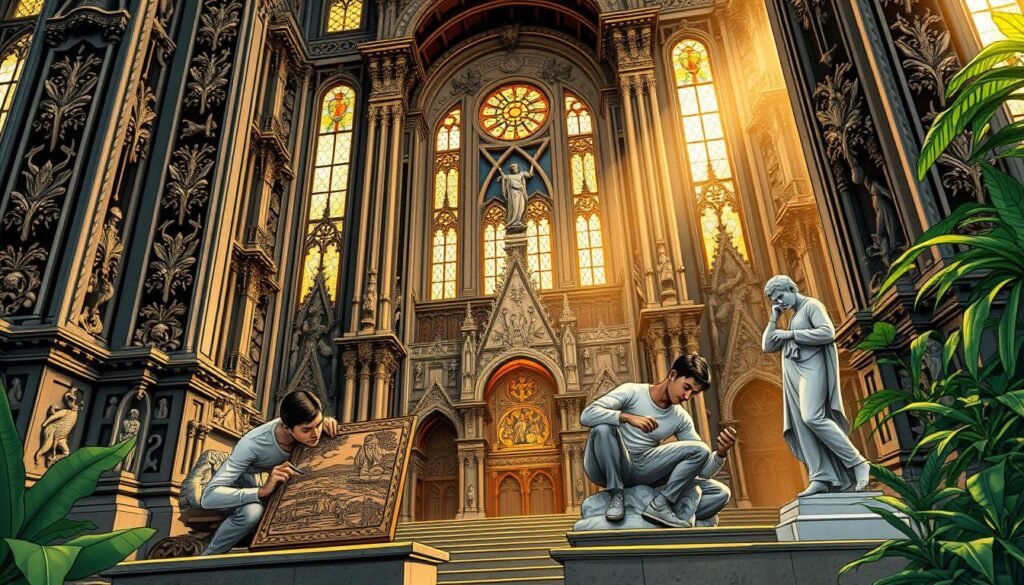
Evolution of Wood Carving and Fine Art Schools
Wood carving remained a vital part of the artistic tradition, but its focus broadened to include secular themes. Artisans began creating intricate designs that reflected everyday life, moving beyond religious motifs. This adaptation showcased the resilience of traditional practices in a changing world.
The establishment of fine art schools played a crucial role in formalizing education. Institutions like the Academia de Dibujo trained local artists in advanced techniques, blending indigenous skills with European methods. These schools became hubs for innovation, fostering a new generation of creators.
Progression of Engraving and Graphic Arts
Engraving and graphic arts emerged as significant mediums during this period. Artists used these techniques to produce detailed works that captured the essence of their time. For example, engravings of historical events became popular, serving as visual records of the nation’s journey.
Graphic arts also gained prominence, with artists experimenting with new materials and styles. This progression allowed for greater creativity and expression, contributing to a broader understanding of three-dimensional art.
Pottery, another integral part of the artistic narrative, evolved with the introduction of new techniques. Artisans began creating intricate designs on ceramics, blending traditional motifs with modern influences. These works became a national symbol of cultural pride.
“The blending of traditional and modern techniques created a unique artistic identity that continues to inspire today.”
This era of expansion laid the foundation for the Philippines’ vibrant artistic legacy. The diversification of techniques and the influence of fine art schools continue to shape the country’s creative landscape, ensuring its rich heritage remains alive.
The Interplay of Indigenous Traditions and Colonial Patronage
Throughout history, the interplay between local customs and foreign patronage has defined the nation’s artistic evolution. This delicate balance allowed indigenous traditions to thrive while embracing new influences introduced by colonizers. The result was a unique blend of cultural heritage and innovation that continues to inspire today.
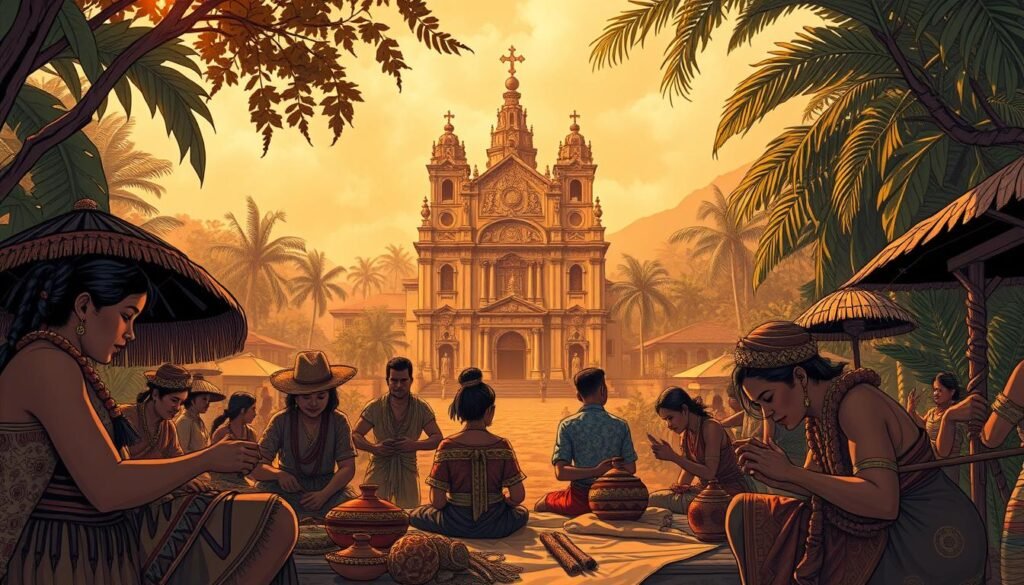
Preserving Heritage Amidst Change
Despite the influx of colonial techniques, indigenous traditions were preserved through the dedication of local artisans. They found creative ways to integrate European methods into their work without losing the essence of their cultural identity. For example, traditional wood carving evolved to include intricate designs inspired by European styles.
Academic institutions played a pivotal role in this cultural synthesis. The establishment of universities like the Academia de Dibujo provided a platform for formal education, blending indigenous skills with European practices. This collaboration ensured that traditional techniques were passed down to future generations.
Case Studies of Cultural Fusion
Local artisans became masters of blending indigenous and European styles. One notable example is the use of gold in religious artifacts, which combined indigenous craftsmanship with Spanish iconography. These works not only served spiritual purposes but also became symbols of cultural pride.
“The fusion of styles was not just an artistic shift but a cultural revolution.”
Another example is the adaptation of traditional weaving techniques to create intricate textiles that incorporated European patterns. This innovation allowed artisans to preserve their heritage while appealing to new markets.
Lasting Impact on Modern Art
The interplay between indigenous traditions and colonial patronage has left a lasting legacy. Modern creators continue to draw inspiration from this fusion, using gold and other traditional materials in contemporary works. This connection to the past ensures that the nation’s artistic identity remains vibrant and relevant.
For more insights into this cultural evolution, explore the interplay of indigenous traditions and colonial in Philippine art.
Conclusion
The journey through the Philippines’ creative heritage reveals a rich tapestry of indigenous traditions and colonial influences. From early practices to the blending of styles during the Spanish era, the nation’s cultural identity has been shaped by resilience and adaptation. Towns like Baguio and local names have played a vital role in preserving this legacy, fostering a deep connection to the past.
Religious themes, secular movements, and the fusion of indigenous and European techniques have left an indelible mark. Institutions and auction houses continue to celebrate these masterpieces, ensuring their stories endure. Traditional practices, such as textile weaving and wood carving, remain a source of pride and inspiration.
As we look to the future, it’s essential to support local creators and honor their contributions. By appreciating these works, we not only preserve a vibrant heritage but also strengthen the nation’s identity. Explore more about this evolution in contemporary Philippine art and its ongoing impact.
FAQ
How did Spanish influence shape the development of local art in the Philippines?
Spanish colonization introduced new techniques, materials, and religious themes, blending European styles with indigenous traditions to create unique visual expressions.
What role did religious art play during the Spanish colonial period?
Religious art became central, with the creation of carved santos, church murals, and other works that integrated Catholic narratives into the cultural fabric.
What are some examples of indigenous practices that influenced pre-Spanish art?
Indigenous practices included oral traditions, ritual art, and the use of ancient visual symbols, which laid the foundation for later artistic developments.
How did European methods and materials transform local craftsmanship?
European techniques like oil painting and wood carving, along with new materials, expanded the scope of artistic expression and elevated craftsmanship.
What secular art forms emerged during the Spanish era?
Portraiture and genre paintings gained popularity, reflecting daily life and social hierarchies while showcasing evolving artistic skills.
How did wood carving evolve under Spanish influence?
Wood carving became more refined, with artisans creating intricate religious figures and decorative items that combined European and local styles.
What is the significance of church murals in Philippine art history?
Church murals served as visual storytelling tools, blending Catholic themes with local aesthetics to educate and inspire communities.
How did indigenous traditions adapt to colonial patronage?
Indigenous artisans blended their cultural heritage with European influences, creating art that reflected both their roots and colonial demands.
Source Links
- The Spanish Colonial Tradition in Philippine Visual Arts – National Commission for Culture and the Arts
- Arts in the Philippines
- History of the Philippines | People, Spain, United States, Revolution, Map, & Facts | Britannica
- Philippine Progress Prior to 1898
- Revolution, Redemption, and Romance: Reading Constructions of Filipino Spanish American Identities and Politics of Knowledge in Rizal’s Noli me Tangere and El Filibusterismo alongside Filipino American Fiction
- King Behind Colonial Curtains: Kasilag and the Making of Filipino National Culture
- The Spanish Influence on Filipino Culture and Language
- Southeast Asian arts – Philippine Music, Dance, Crafts | Britannica
- Catholicism in the Philippines during the Spanish Colonial Period 1521-1898 | 4 Corners of the World
- The Role of Religion in Filipino Art and Literature – Pinas Culture
- Southeast Asian arts | Music, Dance, & Visual Arts | Britannica
- Recognizing the Stranger: The Art of Emmanuel Garibay – Image Journal
- In Focus: Philippine Arts in Context – National Commission for Culture and the Arts
- Islamic arts | Characteristics, Calligraphy, Paintings, & Architecture | Britannica
- Art Studies Journal – The official journal of the Department of Art Studies University of the Philippines Diliman
- The Development of Art Galleries in the Philippines – National Commission for Culture and the Arts
- PHILIPPINE VISUAL ARTS
- The American and Contemporary Traditions in Philippine Visual Arts – National Commission for Culture and the Arts
- Culture of the Philippines
- Philippine Art & Philippine Paintings
- Discover the Best Filipino Art Forms to Learn for Creative Expression

